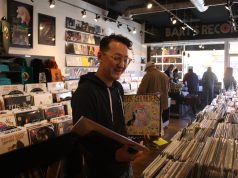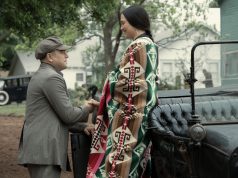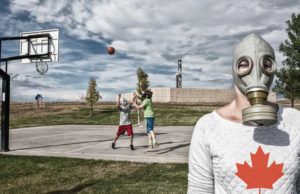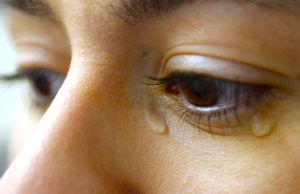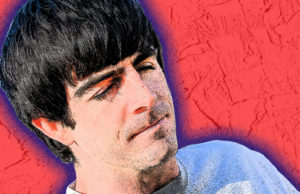We called
We were worried because we knew if Romero were dead,
within minutes he would sit up, begin slouching toward his first victim
and develop a taste for brains. Within days, martial law would be
declared; the
metropolitan areas; within weeks, despite our attempts at staving off
the inevitable, civilization would collapse. It would be every man for
himself. And you, yes, you, sweet mother of three, stoic construction
worker, cocky businessman only looking out for himself, sassy ethnic
character, you would be forced to join ranks and watch as one by one
your unlikely band of survivors were eaten alive until only you
remained. The zombie apocalypse would be upon us.
Call us paranoid. But when Romero’s publicist called to say he was canceling a trip to
Turns out he had a head cold. Good news.
Even better news:
the father of the modern zombie film — heck, the father of the
contemporary oozy undead itself — has a new zombie movie, “Survival of
the Dead,” and it’s only been two years since his previous zombie
flick, “Diary of the Dead,” which itself was two years removed from his
wonderful “Land of the Dead.” Which means, compared with the17 years it
took him to churn out his first three “Dead” pictures, the seminal
“Night of the Living Dead” (1968), the equally revered “Dawn of the
Dead” (1978) and the underrated “Day of the Dead” (1985), and the
20-year undead hiatus after they were complete, we live in a zombie
renaissance.
Then again, we would be living in a zombie fantasia
even if Romero, who turned 70 in February, were, uh, undead — what with
“Shawn of the Dead,” “28 Days Later,” “The Walking Dead” comic book
(soon to be an AMC series), “Zombieland,” “I am Legend,” and the
roughly nine million other zombie-ified pop culture artifacts of the
last decade. Still, to be here, to witness the byproduct of one’s
lifelong advocacy of shuffling sacks of flesh, must be fulfilling?
“I don’t want to disown zombies, some of my best
friends are zombies,” Romero said by phone, chuckling, “but I like to
keep them in the closet until it’s the right time to drag them out and
make a point. With ‘Survival of the Dead’ (which takes place on an
island off
and concerns in-fighting between bands of survivors), it’s that people
can’t seem to disagree without being disagreeable now. See, the biggest
disappointment about the zombie thing today is that not enough people
are using them allegorically or even wisely. It’s just vicious and
malicious and all shock, and there’s not enough fun beneath the horror.
“Some fans, they ask about how this zombie was
killed or how that zombie was killed. They want you to make the same
movie you just made. But to me it’s never been about the zombies in the
first place. I would never make a movie about a zombie apocalypse, and
that would just be what it’s about. I never even called them zombies in
(‘Night of the Living Dead’). I just wanted a situation where the world
around everyone was changing and the people in that world wouldn’t
recognize it until it was too late. Then they still couldn’t come
together and argued among themselves, despite everything happening.”
In short, Romero settled on one of the most flexible and useful, though rarely appreciated, metaphors in pop culture.
Romero himself says he didn’t even appreciate how
potent the metaphor could be until “Night of the Living Dead” was first
screened.
He was a young filmmaker in
shooting commercials, when he decided to make a horror movie with some
friends. It’s a simple picture: Dead people come to life; survivors
hole up in a farmhouse; each of them dies violently, until the last man
standing, played by the African-American actor
It’s one of the most indelible images in 1960s
cinema, though Romero says the role was written with a white actor in
mind. Jones was just the best actor they knew. “He was much more
sensitive to how that last image would be read than I was,” Romero
said. “And he was right, of course, it took on a lot of meaning and the
film became a portrait of1960s America.”
“Night of the Living Dead” became a lot of things: a
snapshot of race relations, the generational divide, a country mired in
an unwinnable war. The filmmaker tried distancing himself. He made a
romantic comedy that was barely released; a handful of horror films,
“The Crazies” (recently remade), “Martin,” some better than others. “I
resisted a long time. I didn’t know what was left to say or how could I
go back to the innocence with which we made that first film.” Until the
late1970s, when he was more socially conscious and he heard about a
huge shopping mall being developed near
With that, he embraced the political readings of
“Night of the Living Dead” and set “Dawn of the Dead” in a mall,
turning out a satire of slouching, impulsive, rabid consumerism.
Basically, film criticism had an impact. “It had to,” he said. “I would
have looked like an opportunistic jerk to just do another one and not
take the idea seriously.”
But for decades the zombie fell out of favor and
Romero’s further sequels trickled out. He made only two more zombie
pictures in the next 25 years, and “because the rights to the first
four are owned by four different groups, I was never able to weave
together the stories the way I wanted to, the way someone like
Which is how “Diary of the Dead” came about — as an
effort to build a little ownership around a subgenre he single-handedly
created. “The film was made fast and for little money, but because it
had a limited release (like “Survival,” it was released to video and
theaters simultaneously) it made a lot of money, so I was able to make
another. Now I’d like these films to be my final word, which at my age,
it may be. And have characters in one show up in the next film and find
them in new situations and lay out my own rules and not have it just be
about whether zombies should run — which people actually debate.”
Should they run?
“No! Maybe if they have a virus, but if they’re dead they’re having a hard enough time just walking!”
He stops himself. He’s overanalyzed himself, he
said. He shouldn’t overanalyze zombies. The other day he was doing a
crossword puzzle with his girlfriend. The clue was “Dead Director.”
“I was puzzling and puzzling and then I realized, ‘Oh, it’s me!’ So there you go. I get too much credit for all this.”
———
(c) 2010, Chicago Tribune.
Visit the
Distributed by McClatchy-Tribune Information Services.


